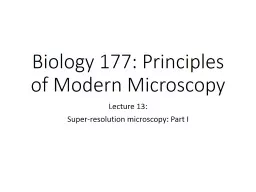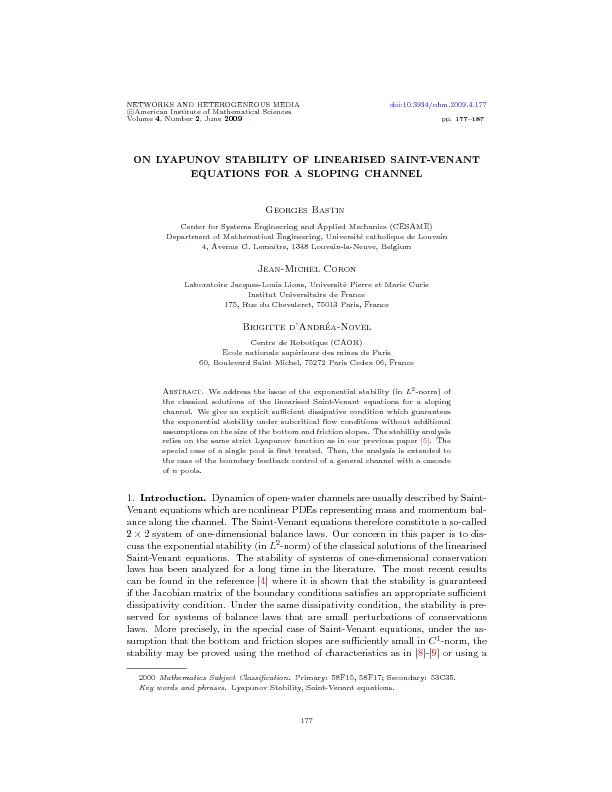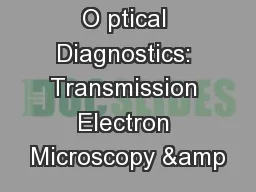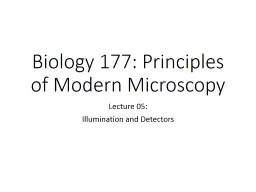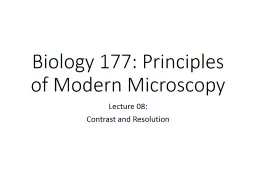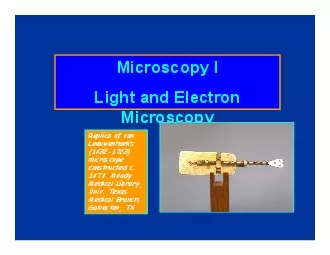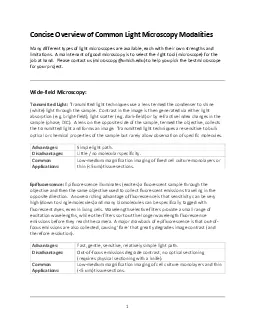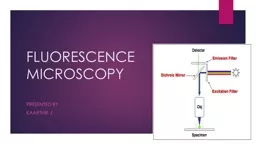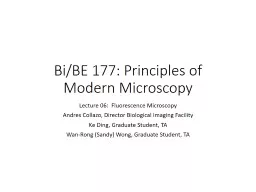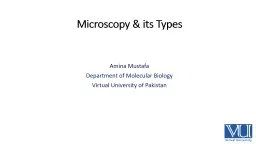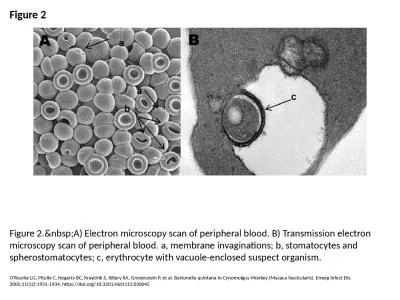PPT-Biology 177: Principles of Modern Microscopy
Author : trish-goza | Published Date : 2016-04-23
Lecture 13 Superresolution microscopy Part I Lecture 13 Fluorescent labeling multi sprectral imaging and FRET Review of previous lecture FRET FLIM Super resolution
Presentation Embed Code
Download Presentation
Download Presentation The PPT/PDF document "Biology 177: Principles of Modern Micros..." is the property of its rightful owner. Permission is granted to download and print the materials on this website for personal, non-commercial use only, and to display it on your personal computer provided you do not modify the materials and that you retain all copyright notices contained in the materials. By downloading content from our website, you accept the terms of this agreement.
Biology 177: Principles of Modern Microscopy: Transcript
Lecture 13 Superresolution microscopy Part I Lecture 13 Fluorescent labeling multi sprectral imaging and FRET Review of previous lecture FRET FLIM Super resolution microscopy NSOM. Lecture . 07: . Confocal Microscopy. Adding the Third Dimension. Lecture . 7: Confocal Microscopy. Optical Sectioning: adding the third dimension. Wide-field . Imaging. Point . Spread Function. Deconvolution. doi:10.3934/nhm.2009.4.177 c AmericanInstituteofMathematicalSciencesVolume4,Number2,June2009pp.177{187 Abstract. 5 4 8 ]-[ 9 ]orusinga 2000MathematicsSubjectClassi cation.Primary:58F15,58F17;Secondary Fire Protection Laboratory Methods Day. June 25, 2014. Paul M. Anderson. Graduate Research Assistant. University of Maryland. Department of Fire Protection Engineering. Transmission Electron Microscopy. Lecture 05: . Illumination and Detectors. Lecture 5: Illumination and Detectors. Review diffraction. Illumination sources. Tungsten-Halogen. Mercury arc lamp. Metal Halide Arc lamps. Xenon Arc lamps. Lecture . 08: . Contrast and Resolution. Lecture 8: Contrast and Resolution. Bright-field. Tinctorial. dyes: the first contrast. Review . of Kohler Illumination. Tradeoffs . in Contrast/Resolution. Dark . Replica of van 1670 Moody Use the information in this tutorial to supplement the visuals in lab and the Chapters 1 8 and 9 in your lab manual Replica of Culpepper tripod microscope built c 1725 by Co 1Many different types of light microscopesare available each with their own strengths and limitationsA main tenant of good microscopy is to select the right tool microscope for the job at handPlease c KAARTHIK J. INTRODUCTION. A fluorescence microscope is a optical microscope that uses fluorescence and phosphorescence instead of , or I addition to reflection and absorption to study properties of organic or inorganic substances.. Lecture 06: Fluorescence Microscopy. Andres Collazo, Director Biological Imaging Facility. Ke Ding, Graduate Student, TA. Wan-Rong (Sandy) Wong, Graduate Student, TA. Lecture 6: Fluorescence Microscopy. Amina Mustafa. Department of Molecular Biology. Virtual University of Pakistan. Invented by :. Antonie. van Leeuwenhoek. (Father of Microbiology). Microscopy. USES:. Diagnostics. Identification. Histology – Tissue analysis. AIM : T THEORY: Microscope is the most commonly used piece of apparatus in the laboratory. It produces greatly enlarged images of minute objects. LIGHT MICROSCOPE A Light Microscope can be simple or (SEM) Electron Microscopy (SEM) and TEM Scanning electron microscopy is used for inspecting topographies of specimens at very high magnifications using a piece of equipment called the scanning electr O'Rourke LG, Pitulle C, Hegarty BC, Kraycirik S, Killary KA, Grosenstein P, et al. Bartonella quintana in Cynomolgus Monkey (Macaca fascicularis). Emerg Infect Dis. 2005;11(12):1931-1934. https://doi.org/10.3201/eid1112.030045. Prepare for your AP Biology exam with confidence using these expertly crafted questions and answers. Dive into key topics and gain insights into effective study strategies.
Download Document
Here is the link to download the presentation.
"Biology 177: Principles of Modern Microscopy"The content belongs to its owner. You may download and print it for personal use, without modification, and keep all copyright notices. By downloading, you agree to these terms.
Related Documents

